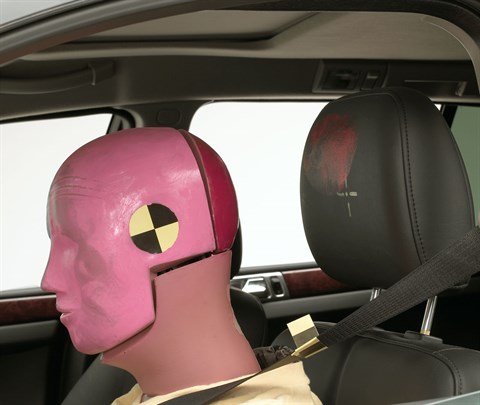Moderate overlap front: original test
Rating applies to 2004-08 models
Tested vehicle: 2004 Chrysler Pacifica 4-door 4wd
The Chrysler Pacifica was introduced in the 2004 model year and discontinued after the 2008 model year.
| Overall evaluation | |
|---|---|
| Structure and safety cage | |
| Driver injury measures | |
| Head/neck | |
| Chest | |
| Leg/foot, left | |
| Leg/foot, right | |
| Driver restraints and dummy kinematics |

Action shot taken during the frontal offset crash test.

The dummy's position in relation to the steering wheel and instrument panel after the crash test indicates that the driver's survival space was maintained reasonably well.

Dummy movement was well controlled. During rebound, the dummy's head hit only the head restraint, as indicated by smeared greasepaint.

A knee airbag is housed behind the knee bolster plastic trim. Injury measures on the upper and lower legs were low, but not lower than in many vehicles with conventional bolsters.
Measures of occupant compartment intrusion on driver side
| Test ID | CEF0312 |
|---|---|
| Footwell intrusion | |
| Footrest (cm) | 16 |
| Left (cm) | 20 |
| Center (cm) | 16 |
| Right (cm) | 14 |
| Brake pedal (cm) | 13 |
| Instrument panel rearward movement | |
| Left (cm) | 5 |
| Right (cm) | 6 |
| Steering column movement | |
| Upward (cm) | 2 |
| Rearward (cm) | 7 |
| A-pillar rearward movement (cm) | 2 |
Driver injury measures
| Test ID | CEF0312 |
|---|---|
| Head | |
| HIC-15 | 168 |
| Peak gs at hard contact | no contact |
| Neck | |
| Tension (kN) | 1.3 |
| Extension bending moment (Nm) | 26 |
| Maximum Nij | 0.26 |
| Chest maximum compression (mm) | 36 |
| Legs | |
| Femur force - left (kN) | 3.8 |
| Femur force - right (kN) | 1.5 |
| Knee displacement - left (mm) | 4 |
| Knee displacement - right (mm) | 1 |
| Maximum tibia index - left | 0.61 |
| Maximum tibia index - right | 0.45 |
| Tibia axial force - left (kN) | 1.8 |
| Tibia axial force - right (kN) | 1.9 |
| Foot acceleration (g) | |
| Left | 61 |
| Right | 49 |
Head restraints & seats
Seat type: All seats
| Overall evaluation | |
|---|---|
| Dynamic rating | |
| Seat/head restraint geometry |
| Seat type | All seats |
|---|---|
| Geometry | |
| Backset (mm) | 80 |
| Distance below top of head (mm) | 45 |
| Seat design parameters | |
| Pass/fail | Fail |
| Max T1 acceleration (g) | 9.9 |
| Head contact time (ms) | 109 |
| Force rating | 3 |
| Neck forces | |
| Max neck shear force (N) | 277 |
| Max neck tension (N) | 716 |
About the head restraint & seat test
Currently, IIHS tests apply only to front seats.
